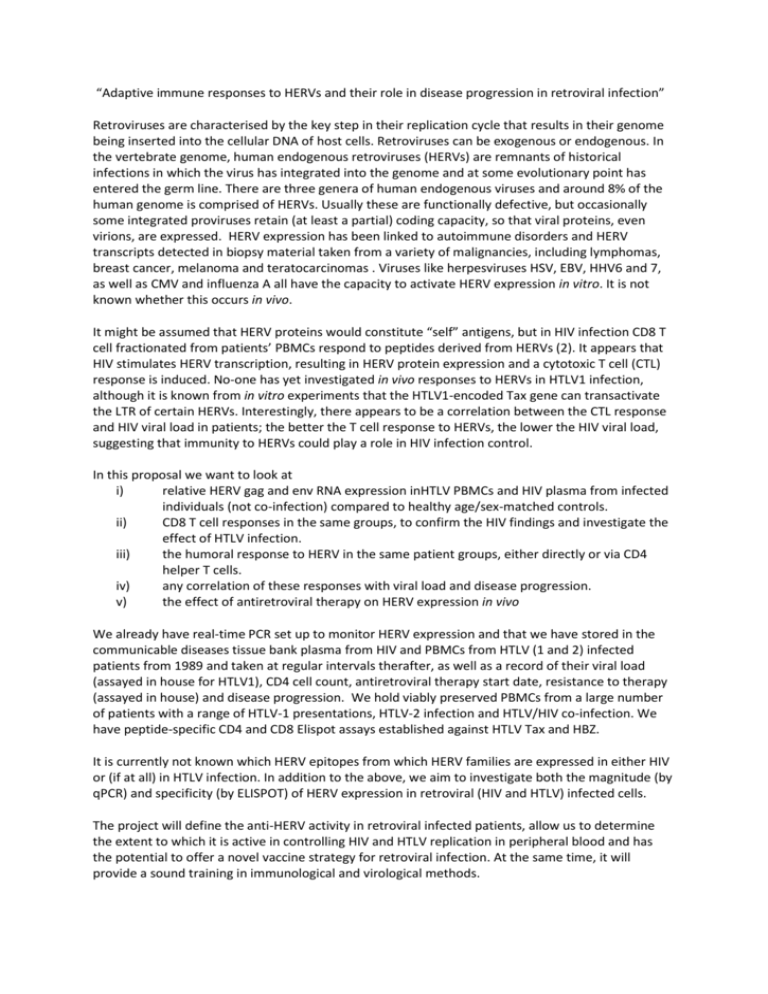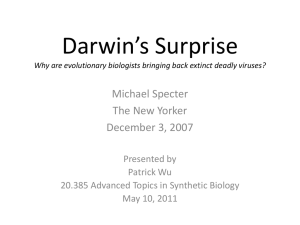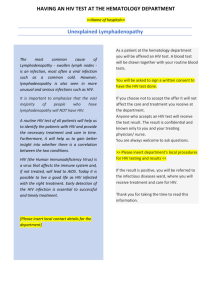“Adaptive immune responses to HERVs and their role in disease
advertisement

“Adaptive immune responses to HERVs and their role in disease progression in retroviral infection” Retroviruses are characterised by the key step in their replication cycle that results in their genome being inserted into the cellular DNA of host cells. Retroviruses can be exogenous or endogenous. In the vertebrate genome, human endogenous retroviruses (HERVs) are remnants of historical infections in which the virus has integrated into the genome and at some evolutionary point has entered the germ line. There are three genera of human endogenous viruses and around 8% of the human genome is comprised of HERVs. Usually these are functionally defective, but occasionally some integrated proviruses retain (at least a partial) coding capacity, so that viral proteins, even virions, are expressed. HERV expression has been linked to autoimmune disorders and HERV transcripts detected in biopsy material taken from a variety of malignancies, including lymphomas, breast cancer, melanoma and teratocarcinomas . Viruses like herpesviruses HSV, EBV, HHV6 and 7, as well as CMV and influenza A all have the capacity to activate HERV expression in vitro. It is not known whether this occurs in vivo. It might be assumed that HERV proteins would constitute “self” antigens, but in HIV infection CD8 T cell fractionated from patients’ PBMCs respond to peptides derived from HERVs (2). It appears that HIV stimulates HERV transcription, resulting in HERV protein expression and a cytotoxic T cell (CTL) response is induced. No-one has yet investigated in vivo responses to HERVs in HTLV1 infection, although it is known from in vitro experiments that the HTLV1-encoded Tax gene can transactivate the LTR of certain HERVs. Interestingly, there appears to be a correlation between the CTL response and HIV viral load in patients; the better the T cell response to HERVs, the lower the HIV viral load, suggesting that immunity to HERVs could play a role in HIV infection control. In this proposal we want to look at i) relative HERV gag and env RNA expression inHTLV PBMCs and HIV plasma from infected individuals (not co-infection) compared to healthy age/sex-matched controls. ii) CD8 T cell responses in the same groups, to confirm the HIV findings and investigate the effect of HTLV infection. iii) the humoral response to HERV in the same patient groups, either directly or via CD4 helper T cells. iv) any correlation of these responses with viral load and disease progression. v) the effect of antiretroviral therapy on HERV expression in vivo We already have real-time PCR set up to monitor HERV expression and that we have stored in the communicable diseases tissue bank plasma from HIV and PBMCs from HTLV (1 and 2) infected patients from 1989 and taken at regular intervals therafter, as well as a record of their viral load (assayed in house for HTLV1), CD4 cell count, antiretroviral therapy start date, resistance to therapy (assayed in house) and disease progression. We hold viably preserved PBMCs from a large number of patients with a range of HTLV-1 presentations, HTLV-2 infection and HTLV/HIV co-infection. We have peptide-specific CD4 and CD8 Elispot assays established against HTLV Tax and HBZ. It is currently not known which HERV epitopes from which HERV families are expressed in either HIV or (if at all) in HTLV infection. In addition to the above, we aim to investigate both the magnitude (by qPCR) and specificity (by ELISPOT) of HERV expression in retroviral (HIV and HTLV) infected cells. The project will define the anti-HERV activity in retroviral infected patients, allow us to determine the extent to which it is active in controlling HIV and HTLV replication in peripheral blood and has the potential to offer a novel vaccine strategy for retroviral infection. At the same time, it will provide a sound training in immunological and virological methods. Further reading: Weiss RA. The discovery of endogenous retroviruses. Retrovirology (2006), 3:67. Garrison KE, Jones RB, Meiklejohn DA, Anwar C et al. T Cell Responses to Human Endogenous Retroviruses in HIV-1 Infection. PLoS Pathogens (2007), 3(11):e165. Van der Kuyl C. HIV infection and HERV expression: a review. Retrovirology (2012), 9:6





